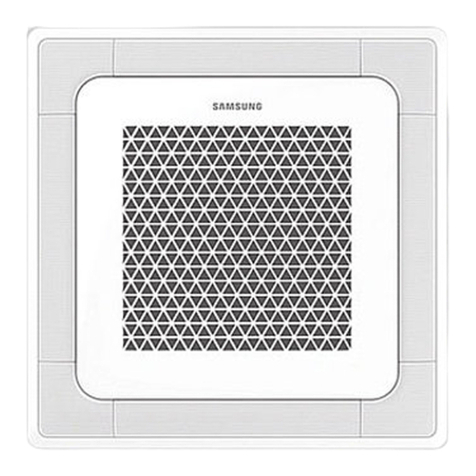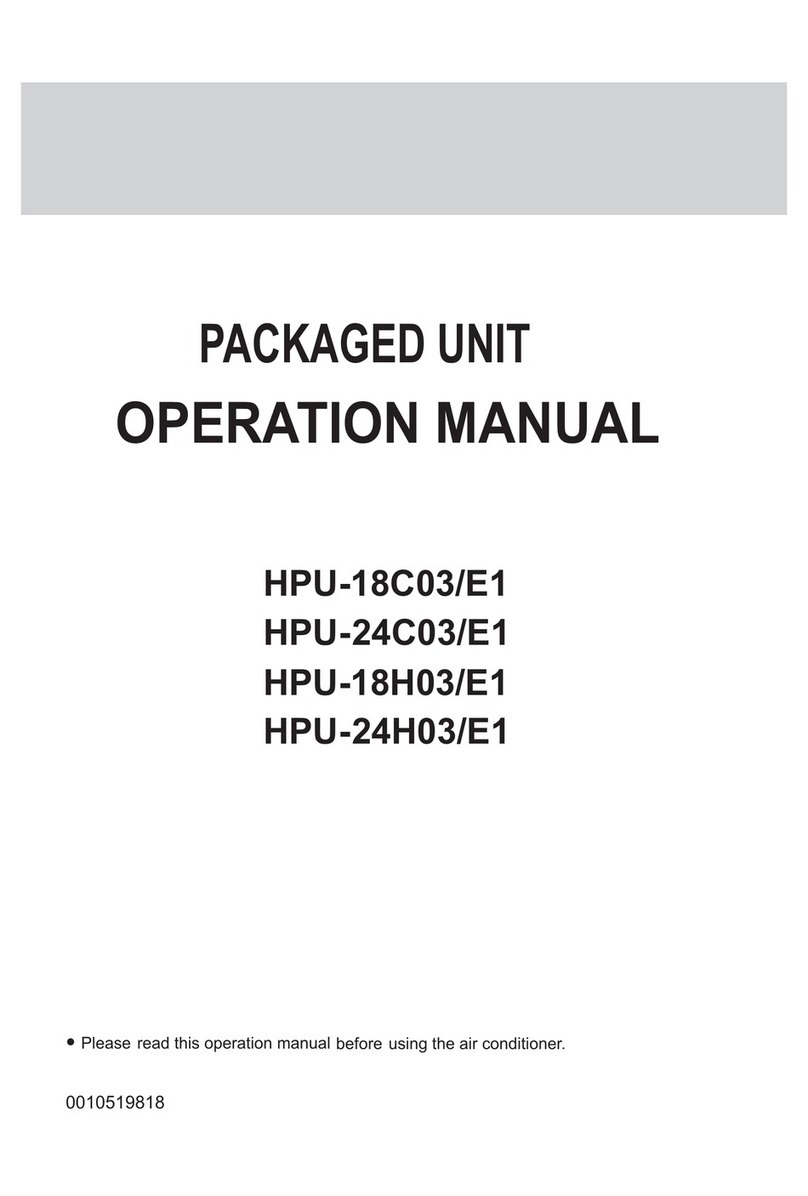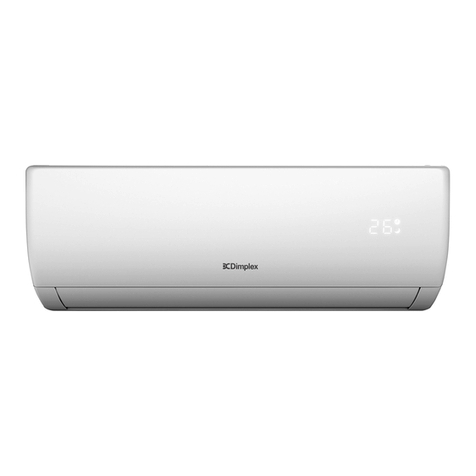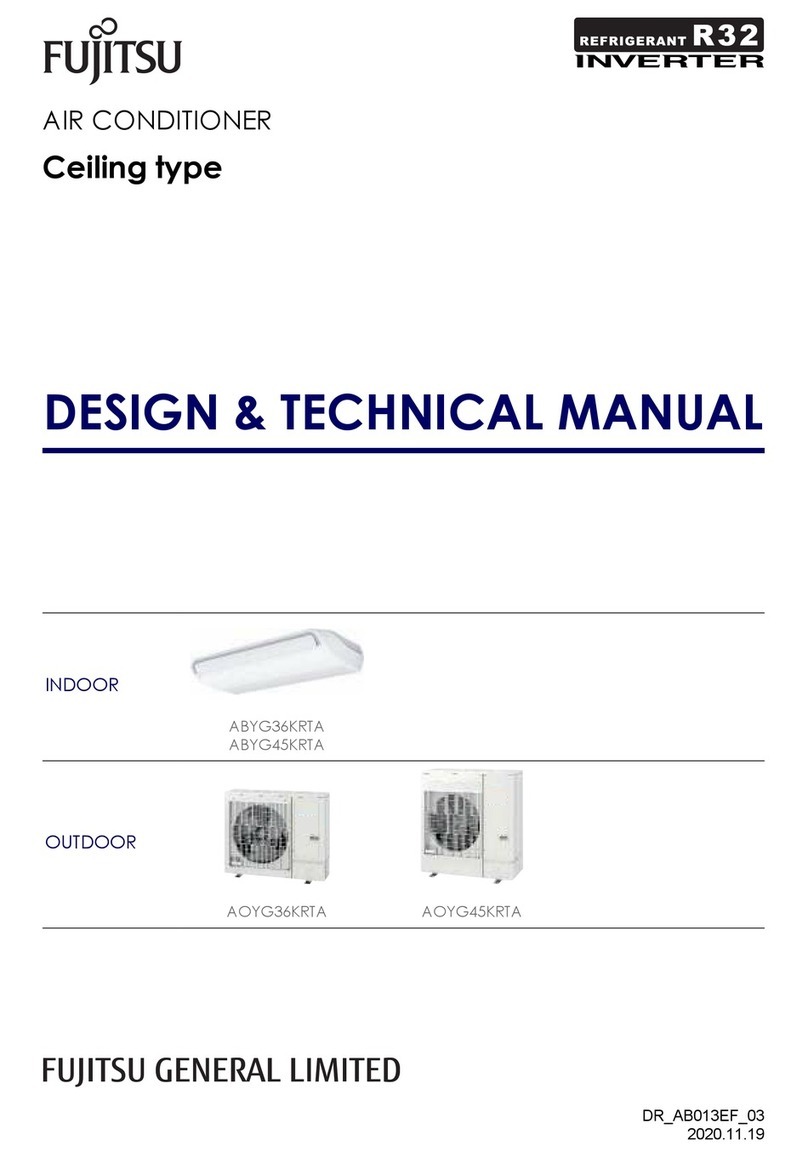NORDIK 15625026 User manual

WINDOW AIR CONDITIONER
User Manual (p.1)
15625026
Model / Modèle :
GJC08CI-A3NRNA5A
v
DE FENETRE
CLIMATISEUR
Guide de l'utilisateuUS


You will find inside
air conditioner (AC).
AC disabled
AC.
this manual
1. SAFETY PRECAUTIONS.....................................................................2
2. ELECTRICAL REQUIREMENTS AND CONNECTION.......................5
3. INSTALLATION INSTRUCTIONS........................................................6
4. CONTROLS........................................................................................15
5. AIR CONDITIONER FEATURES........................................................17
6. CARE AND CLEANING......................................................................18
7. ENERGY SAVING 7,36...................................................................19
8. TROUBLESHOOTING........................................................................20
9. WARRANTY.........................................................................................21
1
an
an to be used

grounding.
grounding
A damaged appliance
place
2
towards
smells
injuries
injuries.
injuries
below:
machine failure
cause an
in the
the unit.
the room the air
the power cord's
:

any other
purpose than air cooling.
3
Otherwise, an
or
open windows
water entering
the house
Make sure the outdoor installation
bracket is not damaged.
objects
The appliance's surfaces
may become discoloured or
scratched.
Unplug the appliance
it off
operating
the air
the air
thinner,
injuries.
appliance failure If the bracket is damaged, the
unit may fall and cause damage.
or an
the filters
the
product failure
the unit when the

with a new cord - please
Please contact Customer Service.
If the
contact Customer Service.
Safety Precautions
Current Device Operation
repaired; it
vapours
plugged
AC
After pressing
After pressing there will be another
there will be a
fails to
.
Current
product manufacturer
AC
AC
AC
run the AC
cord,
the side
AC
Device Operation
three

Electrical shock and personal injury hazard
Electrical ground is required for this appliance.
DO NOT ground to a gas line.
If the cold water pipe is interrupted by plastic,
non-metallic gaskets, or other insulating
materials,
If there is any doubt, check
grounded.
DO NOT use for grounding.
DO NOT modify the power plug. If it
does not fit the outlet, please install a proper
outlet by a qualified electrician.
DO NOT have a fuse in the neutral or
grounding circuit. A fuse in the neutral or
grounding circuit could result in an elecrtrical
shock.
DO NOT use an extension cord for this
appliance.
Failure to follow these instructions could result in
electrical shock, serious injuries, or death.
WARNING
OBSERVE ALL LOCAL GOVERNING CODES
AND ORDINANCES.
DO NOT, UNDER ANY CIRCUMSTANCES,
REMOVE THE GROUNDING PRONG FROM
THE POWERSUPPLY CORD.
ELECTRICAL REQUIREMENTS
A 115-V (103.5 min, 126.5 max), 60-Hz, AC only,
15-A fused electrical supply is required. A time
delay fuse or time delay circuit breaker is also
required. A separate circuit, serving only this
appliance, MUST be provided.
NOTE: If the codes permit and a separate
grounding wire is used, it is recommended that a
qualified electrician determines that the grounding
path is adequate and not interrupted by plastic,
non-metallic gaskets, or other insulating materials.
RECEPTACLE WIRING
Receptacle wiring should be a minimum of 14
gauge. Use copper wires only. It is your responsibility
to provide proper receptacle wiring, installed by
a qualified electrician.
Recommended grounding method:
For your personal safety, this appliance must be
grounded. This AC includes a power
supply cord with a three-prong grounding plug. To
minimize possible electrical shock hazards:
-The cord must be plugged into a mating
three-prong grounding-type wall receptacle;
-It must be grounded in accordance with the
National Electrical Code (ANSI/NFPA 70-
latest version); and
-all local codes and ordinances must be followed.
If a mating three-prong grounding-type wall receptacle is
not available, it is the responsibility of the consumer
to have a properly grounded three-prong wall receptacle
installed by a qualified electrician.
Electrical connection
Electrical ground is required for this appliance.
Three-prong
grounding plug
Three-prong
grounding-type
wall receptacle
Grounding
prong
Power supply cord
(6 feet long)
Electrical Requirements and Connection
5

Preparation for installation
For wood-frame casement windows: It may be
necessary to construct a frame, using at least 1"
thick wood, with a 15-1/2" wide opening.
For brick or cement building construction: It may
be necessary to put a wooden strip under the AC, for
mounting purposes.
Installation tips
Tools required (not included)
Flathead screwdriver
Phillips-head screwdriver
Carpenter's level
Fine-toothed saw
Electric or hand drill
WARNING
Failure to adhere to the following precautions could
result in personal injuries and product damage.
Because this unit weighs about 88 to 105 lb,
it is recommended that you have someone help
you when installing your new unit and that you both
use proper lifting techniques. Inspect the condition
of the window where the unit will be installed. Be
sure it will support the weight of the unit.
This appliance must be installed according to all
applicable codes and ordinances.
Handle the AC with care. AVOID touching sharp
metal fins on front and rear coils.
Make sure your AC does not fall during installation.
Do not use water collected in the unit for drinking
purposes. It is not sanitary.
Knife and scissors
Pencil
NOTE: These instructions describe the installation in a typical wood-framed window with a wood SLIDE-BY
sash, or installation in a metal CASEMENT window. Modification may be necessary when installing in windows
made differently than those shown in these instructions.
A high window accessory kit is available for window heights up to 62" (1575 mm). Part # EA103W.
Installation Instructions
6
Measuring tape

1. Make sure youhaveall the necessaryparts. If any part is
found missing or damaged, do not attempt to install the
AC. Contact Customer Service for assistance.
Installation kit contents:
1. Platform (1)
2. Support brace (1)
3. Adjustment bolt (1)
4. Hex flange nut - 1/4" (1)
5. Track seal (1)
6. Side channel seal (1)
7. Foam seal strip/sash seal
8. Safety bracket (1)
9-11. Screw - #10 x 2-1/2" flathead (2), OR
Screw - #10 x 1-3/4" pan-head (2), OR
Screw - #10 x 1" pan-head (2)
12. Screw - #8 x 3/4" pan head (6)
13. Screw - #8-32 x 3/4" self-threading (7)
14. Window locking bracket (1)
15. Plastic window panel (1)
16. Side channel (2)
17. Screw - #8 x 3/8 truss head (6)
18. Panel frame/seal assembly (1)
NOTE:Use the scale below to measurethe length of your
(13 mm)
(10 mm) (19 mm) (28 mm) (50 mm)
(25 mm) (44 mm) (63 mm)
screws. The scalewillcomeinhandywhen
separating screws forinstallation.
2. Choose a propersizedwindow, as shownon the right.
15-1/2" minimumwidth
16-1/4" maximumwidth (for
casement windows)
21-1/4" minimumheight (with
window panelretainer)
20-5/16" minimumheight
(window panel retainer removed)
39-7/16" maximumheight
NOTE:Heightmeasurementmust be of a clear
openingabovemounting platform. In somecases,
due to a variety of stopand track arrangements, the
abovedimensionsmay varyslightly. If necessary,
installation can be made by alternating window
jambs. (refer to "Alternate Window Jamb Applications")
(continued)
IDENTIFY SCREWS
BY LENGTH
3
19, 10, 11
8
2
13
12
5
7
17
4
16
14
15
6
18
1
16 / "
4
maximum
width
(casement
windows)
1
15 / "
2
minimum
width
5
20 / "
16
minimum
height
7
39 / "
16
maximum
height
Installation Instructions
7

Choose a window that allows the cooled air to flow
freely and directly into the room(s) you wish to cool.
Remember, it is difficult to move air around corners.
Also, choose a window that is within 6 feet of an
electrical outlet. (refer to Electrical Requirements/
Receptacle wiring needs) Do not use an
3. Choose a proper window location.
Installing the unit in a sliding window
1. Attach the support brace to the platform as shown.
Use the adjustment bolt and hex flange nut to complete the
assembly. Choose slot and adjustment bolt hole
locations that will create a 45-degree angle between
the platform and the support brace. Try the assembly in the
window to determine if the platform will rest properly and
allow a proper slope (3/16" lower on the outside).
NOTE: If you are planning to use a siding-
protection board (refer to Step 5) on the outside of your
house, hold the board in place when testing the assembly
in the window.
2. Measure and lightly mark a line 8-11/16"
from the window jamb.
NOTE: If any sash stop protrudes more than 1"
from the side window jambs, the 8-11/16"
measurement must be increased accordingly.
Screen and storm window frames may also require
adjustments to the measurement.
3. Center the platform assembly on the line with the
inside platform tab pressed against the inside edge of
the window track. Using the holes in the platform as a
guide, mark and drill two 9/64" diameter holes. Drill
holes in either track or stool.
(continued)
Property damage hazard-Failure to adhere to
the following precautions could result in
damage to the window or air conditioner.
Be sure the wood stool or window track is securely
attached to the building construction. Use longer
screws in the sub-framing if necessary.
CAUTION
6-foot
power cord
reach
Platform assembly
1/ " (6 mm) HEX FLANGE NUT
4
11
8 / "
16
Center the platform
assembly on the
line with the platform
tab pressed against the
window track
Alternate screw location
(depending on the stool depth)
Platform tab
Window track Window seal
Installation Instructions
8
extension cord.

4. Peel off the protective backing from the track seal. Apply
the seal to the room side of the window track. Center of the
seal strip should be aligned with the line marked in Step 2.
Those two screw holes drilled in Step 3 should be directly
above the seal strip in the inner track.
5. Securely attach a siding-protection board to the
side of the house.
NOTE: The siding-protection board should be long
enough to span two wall studs.
6. Place the platform assembly, with the platform tab
against inside the window track, and attach it to the
window jamb. Use appropriate length screws (Items
9-11 in the "Preparing for installation" section).
7. Adjust the platform assembly so that the outside edge
is 3/16" lower than the inside edge, as shown on the right.
This ensures proper water drainage from the air
conditioner.
8. Level the platform assembly from side to side.
Also make sure the window track is level. Use levelling
shims as necessary to ensure the unit is level from side
to side.
9. Measure the height of the window opening from the top
of the platform assembly as shown on the right. Subtract 20-5/8".
Mark this measurement on the plastic window
panel along the longer side. (continued)
Apply the track seal
to the window side
of the track.
Inside
wall of the
house
Siding-protection
board
The outside edge is 3/16"
lower than inside.
Put the platform
tab against
the inside of the
track.
Measure the
distance and
subtract
5
20 / ".
8
Installation Instructions
9

Slide the inner
window sash
firmly against
the cabinet.
10. Clamp the plastic window panel between a board
and a work table, and cut along the cutting line with a fine-
toothed saw. Remove any burrs with a file.
11. Fasten the side channels to the sides of the AC
using three screws (Item 17) per channel. Start with the first
screw at the top of the channel. Make sure channel hook ends
face towards the back of the unit.
12. Slide the plastic window panel into the panel frame,
with the smooth side towards the room. Slide the panel frame
assembly into the side channels of the AC cabinet. Make
sure the plastic window panel is firmly enclosed on all
sides by the retainer grooves.
13. Cut the side channel seal into two equal lengths.
Remove the protective backing and apply it to the rear
side of the cabinet side channels, starting just below the
panel frame assembly. Pinch off the excess length so the
seal is even with the bottom of the cabinet side
channel.
14. To remove the front panel
1. Remove the two front retaining screws from the
front frame.
2. Press firmly on each side of the metal case close
to the front, approximately 2/3 of the way down.
3. While pressing on the sides of the metal case,
gently pull the front out and lift up to release it
from the case.
4. Then remove the four screws from the front frame
to release the control panel box.
NOTE: DO NOT push or pull the air direction louvers.
15. Place the AC in the window opening. As shown on the
right, it should sit on the platform assembly so that the window
panel frame and cabinet side channels are against the top
and side window jambs. (continued)
Panel frame
Plastic window panel
Apply the weather
seal to the side
channels just
below the edge of the
panel frame.
retaining
screw
Fastening side channels
Screw
Installation Instructions
10

16. Slide the inner window sash firmly against the side
of the cabinet. Make sure not to peel the seal strips
from the window track and cabinet side channels. If
the panel frame does not fit snugly to the inner
window sash, secure the panel frame to the sash
with #8x3/4" screws or #8-32x3/4" self-
threading screws. Use the partially plugged holes in
the panel frame. Drill 1/8" pilot holes for the
screws.
17. Hook the safety bracket over the base of the
unit and fasten it to the front of the platform
assembly. Use a #8-32x3/4" self-threading
screw.
NOTE: The bracket prevents movement of the
AC (either in or out) after completing the installation.
18. Stuff the foam seal strip/sash seal between
the vertical sash and the window glass, as shown
on the right.
19. Use the window locking bracket to lock the
inner window sash to the base of the outer window
sash. Use one #8x3/4" screw or #8-32x3/4"
self-threading screw. Drill a 1/8" pilot hole.
20. To replace the front panel
First reconnect the coupler plugs, then position the
exhaust control through the front in the proper
location. Gently push the front into position on the
cabinet. It should click into place. Then replace the
retaining screws that holds the panel in place.
Do not push or pull the front panel louvers.
Alternate window jamb
applications
To install your AC in windows having no
flanges or wood stops on the top and side jambs, the
channels and panel frame must fit against a mating
flange (or 1/16" max. thick angle) attached to the
window jambs. Figure A shows this angle installed.
Figures B & C show alternate treatments. On the sash
side of the opening, the leading corner of the inner sash
becomes the flange. You can purchase the angle
strip at your local hardware store.
Safety bracket
Install the safety bracket
Sash seal
Window
locking
bracket
Room
Flush
Room
C
Add a 16- or 18-
gauge angle
A
Add an angle to
the wood stop
B
Add wood
as shown
Room
Slide the inner
window sash
firmly against
the cabinet.
Installation Instruction
11

Installing the unit in a casement
window
NOTE: Open the window to the maximum amount to
allow for clearance of the cabinet. The crank handle
should be removed to allow the platform to be
fastened to the jamb. If the window cannot open far
enough (more than 15-1/2") for the cabinet to
clear the window, remove the window entirely by
drilling out the rivets. Bolts can serve as the pivots in
the future.
To avoid crank handle and window clearance
problems, the unit can be installed in a stationary
sash section. However, the horizontal mullion and the
two-glass panels must be removed before installation.
1. Attach the support brace to the platform as shown.
Use the adjustment bolt and hex flange nut to complete
the assembly. Choose the slot and adjustment bolt
hole locations that will create a 45-degree angle
between the platform and the support brace. Try the
assembly in the window to determine if the platform
will rest properly and allow the proper slope (3/16"
lower on the outside).
NOTE: If you are planning to use a siding-
protection board (refer to Step 6) on the outside of your
house, hold the board in place when testing the
assembly in the window.
2. Drill a 9/64" diameter pilot hole in the window
jamb at an equal distance from each side of the
jamb and 3/16" up from the window sill. If the
hole coincides with the window lever slot in the jamb
bottom, an additional hole will need to be drilled
through the platform edge and window jamb to
miss this slot.
3. Peel off the protective backing from the track
seal, and stick the seal to the window sill on the
outside of the bottom jamb.
4. Screw the platform assembly to the window
jamb through the pilot hole you drilled in Step 2. Use
a #8x3/4" self-threading screw. (continued)
Platform assembly
1/ " (6 mm) HEX FLANGE NUT
4
11
8 / "
16
Equal distance from both sides
Apply the track seal to the outside
edge of the bottom window jamb.
Screw
Track seal
Window
jamb
Installation Instructions
12

5. Adjust the platform assembly so that the rear of
the AC will be 3/16" lower than the front. This ensures
proper water drainage from the AC.
NOTE: A projection below the base of the AC
will require the rear of the platform to be
7/16" lower than the front to create the 3/16"
slant from front to rear.
6. Securely attach a siding-protection board to the
side of the house where the platform assembly hits the
house. The siding-protection board should be long
enough to span two wall studs.
7. Measure the height of the window opening
from the top of the platform assembly. Subtract
20-5/8". Mark this measurement on the plastic
window panel, along the longer side.
8. Clamp the plastic window panel between a
board and a work table, and cut along the cutting line
with a fine-toothed saw. Remove any burrs with a file.
9. Fasten the side channels to the sides of the
unit using three screws (Item 17) per channel. Make
sure the channel hook ends face towards the back of
the unit.
10. Slide the plastic window panel into the panel
frame with the smooth side towards the outside. Slide the
panel frame assembly into the side channels of the
AC cabinet. Make sure the plastic window panel is
firmly enclosed on all sides by the retainer
grooves. (continued)
The rear is at least
7/16" lower
than the front.
Fasten the siding-
protection board to
the house siding.
Panel frame
Plastic window panel
Measure
the distance
and subtract
5
20 / ".
8
Installation Instructions
13

11. Cut the side channel seal into two equal lengths.
Remove the protective backing and apply it to the
rear side of the cabinet side channels, starting just
below the panel frame assembly. Pinch off the excess
length so the seal is even with the bottom of the
cabinet side channel.
12. To remove the front panel
NOTE: DO NOT push or pull the air direction louvers.
13. Place the AC in the window opening
as shown on the right. It should sit on the
platform assembly so that the window panel frame
and cabinet side channels are against the top and
side window jambs. Side channels should overlap
side window jambs equally.
14. Drill two 9/64" diameter pilot holes in the
top window jamb in line with the partially plugged
holes in the panel frame. Secure the panel frame to
the window jamb with two #8-32x3/4" self-
threading screws. If additional holding is necessary,
two screws may also be used on the sides of the panel
frame.
15. Drill two screw-clearance holes in the cabinet
side channels (near the bottom) and two 9/64"
diameter pilot holes in the side window jambs. Secure
the cabinet side channels to the window jambs with
two #8-32x3/4" self-threading screws. When
doing this, be careful not to twist the side channel
seals with the screws.
NOTE: Inserting screws will prevent the AC
from being pushed into the room.
Apply the weather
seal to the side
channels just below
the edge of the
panel frame.
retaining
screw
1. Remove the two front retaining screws from the
front frame.
2. Press firmly on each side of the metal case close
to the front, approximately 2/3 of the way down.
3. While pressing on the sides of the metal case,
gently pull the front out and lift up to release it
from the case.
4. Then remove the four screws from the front frame
to release the control panel box.
16. To replace the front panel
First reconnect the coupler plugs and position
the exhaust control through the front in the
proper location. Gently push the front into
position on the cabinet. It should click into
place. Then replace the retaining screws that
holds the panel in place.
Do not push or pull the front panel louvers.
Screw
Installation Instructions
14

Mode button
Press this button to set the
The matching indicator light will turn on. Please note that
under Auto mode, no indicator light will turn on.
Cool, Energy Saving,
Fan, Dry, or Auto mode.
Fan Speed button
Press this button to set
Note: Under Dry mode, the fan speed cannot
be adjusted.
Low, Medium,
High, or Auto Fan speed.
Timer Increase /Decrease buttons
Each press of the Increase /Decrease
button on the unit will set the delay time
when using the Timer button on the unit
The Set light will flash while setting.
Temp Increase /Decrease buttons
Press this button to set the temperature under
Cool,
Energy saving
, or Dry mode.
Display
1. Under the ON status without the timer
setting, he operation modes are Auto,
Cool, Energy Saving, Fan, or Dry, and
the set temperature will be displayed.
2. Time will be displayed under the timer set-
ting or timer preview status.
ON/OFF button
Press this button to turn on or turn off
the AC.
Timer button
Timer ON can be set with the AC OFF. When the timer
ON
reaches time, the system will run under the previous set-
ting mode.
Timer OFF can be set with the AC ON. When the timer
reaches OFF time, the unit will turn off. The timer can be
set in 0.5-hour increments below 10 hours and in 1-hour
increments for 10 hours or above.
Filter Check button
After 250 hours of operation, the air filter must be cleaned;
the "Clean Filter" indicator light will turn on.
Note: Once the filter has been cleaned, press the Filter
Check button to clear the warning. The "Clean Filter"
indicator light will turn off.
8
Lights next to the touch pads on the AC control panel indicate the selected settings.
AC controls
Sleep button
Press this button to go into SLEEP mode.
Press it again to cancel the function. This function is
available in Cool, Energy Saving, or Dry mode to
maintain the most comfortable temperature for you.
The setting range is 0.5~24 hr.
Controls
15

Remote control
Remote control
2
7
4
3
8
6
5
1
Press this button to turn on the unit. Press this
button again to turn off the unit.
ON/OFF:
1
MODE:
2
AUTO COOL SAVE FAN DRY
Each time you press the button, a mode is selec-
AUTO, COOL,
SAVE, FAN, and DRY, as shown below:
morfseogtahtecneuqesanidet
Press this button to increase the set temperature.
Holding it down for more than 2 seconds will rapidly
increase the set temperature. In AUTO mode, the
set temperature is not adjustable.
+:
4
3
Press this button to decrease the set temperature.
Holding it down for more than 2 seconds will rapidly
decrease the set temperature. In AUTO mode, the
set temperature is not adjustable.
.
-:
TIMER:
8
Auto
Speed 1 Speed 2
Speed 3
5FAN:
This button is used for setting the fan speed in the
sequence ranging from AUTO, , ,
Speed 4
to , then back to AUTO.
NOTE: Your AC model has three speeds.
6I FEEL:
Press this button to activate the I FEEL function.
Under this function, the sensor in the remote controller
will send the temperature around the remote to the
unit every 10 min, and the unit will cycle to reach the
temperature sent by the remote. Press this button
again to turn off this function.
SLEEP:
7
Press this button to activate the Sleep mode. Within 2
hours after the Sleep mode is activated, the set
temperature will increase by 1℃/2℉per hour. For the entire
night under Sleep mode, the set temperature increase
by 2℃/4℉. Press this button again to turn off the Sleep
mode. The Sleep mode is available in Cool, Energy Saving,
and Dry modes.
the unit Timer On. The T-ON
the unit Timer Off. The T-OFF
Controls
16
Press the + and - buttons simultaneously to lock or unlock
the keypad. If the remote controller is locked, will
point to . In this case, if you press any button,
will blink three times.
Combination of the + and - buttons to lock/unlock
9
When the unit is OFF, press the MODE and - buttons simulta-
neously to switch between and .
Combination of the MODE and - buttons to alternate
between ºC / ºF
10
Energy Saving mode
11
Under Energy Saving mode, both the temperature and
fan speed can be adjusted. The AC will cycle on and off
to maintain the temperature and fan speed you set.
the remote control
d H icon will be blin
Timer Off
king. Within 5 seconds, press the + or - button
the + or - button once
for 2 seconds, to change increments faster. Release the
H icon will stop
blinking.
H icon will be blinking. Within 5 seconds, press the + or - button
the + or - buttonTimer On
for 2 seconds, to change increments faster. Release
H icon willthe TIMER The T-ON
blinking.
s set up, pressCancel Timer On/Off: If the Timer
the TIMER button once to review the remaining time. Within
5 seconds, press the TIMER button again to cancel this
function.
to adjust the time
will increase or decrease the time by 0.5 h. Hold the + or -
button
the TIMER The T-OFF
button after your required set time
to adjust the time
once will increase or decrease the time by 0.5 h. Hold the +
or - button
the button after your required set time
stop

ADDITIONAL THINGS YOU SHOULD KNOW
Now that you have mastered the operating procedure, here are more features in your control that you should become
familiar with.
The Cool circuit has an automatic 3-minute delayed start if the unit is turned off and on
quickly. This prevents overheating of the compressor and possible circuit breaker tripping.
The fan will continue to run during this time.
The control will maintain the set temperature within 1 °F, between 61 F and 86 F.
The control panel can display the temperature in degrees Fahrenheit or degrees Celsius. To convert from one
to the other and back, press and hold the "TEMP/TIMER" Up ( ) and Down ( ) buttons together for 3 seconds.
EXHAUST CONTROL
This exhaust control allows the AC to either recirculate inside air (CLOSED) or exhaust air to the outside (OPEN).
The CLOSED position is used when maximum cooling is desired. It may also be used for air recirculation without
cooling when the AC is set in any FAN position.
The OPEN position removes stale air from the room and exhausts it to the outside. Fresh air is drawn in through
normal passages in the home.
4-WAY LOUVERS
The 4-way air directional louvers allow you to direct
air flow up or down, left or right throughout the room
as needed.
Air Conditioner Features
17

Clean your AC occasionally to keep it looking new. Be sure to
unplug the unit before cleaning to prevent shock or fire hazards.
Winter storage
If you plan to store the AC during winter, remove it carefully from
the window according to the installation instructions. Cover it with
plastic or store it in its original carton.
NOTE: To prevent rust or electrical connections from being damaged,
store the AC in an upright position and a dry place.
Cabinet cleaning
the AC.
round
se
damage to the AC.
re hazards.AC
with a cloth dampened in a solution of warm water and a mild liquid
dishwashing detergent. Rinse thoroughly and wipe dry.
ning is necessary.
Trapped part
of frost on the cooling coils.
Air filter cleaning
, you can vacuum the filter instead of washing it.
Wash the filter using a liquid dishwashing detergent and warm water.
Rinse the filter thoroughly
the filter
.
Care and Cleaning
18
This manual suits for next models
1
Table of contents
Languages:
Popular Air Conditioner manuals by other brands

Samsung
Samsung AS10U Series User's manual & installation manual
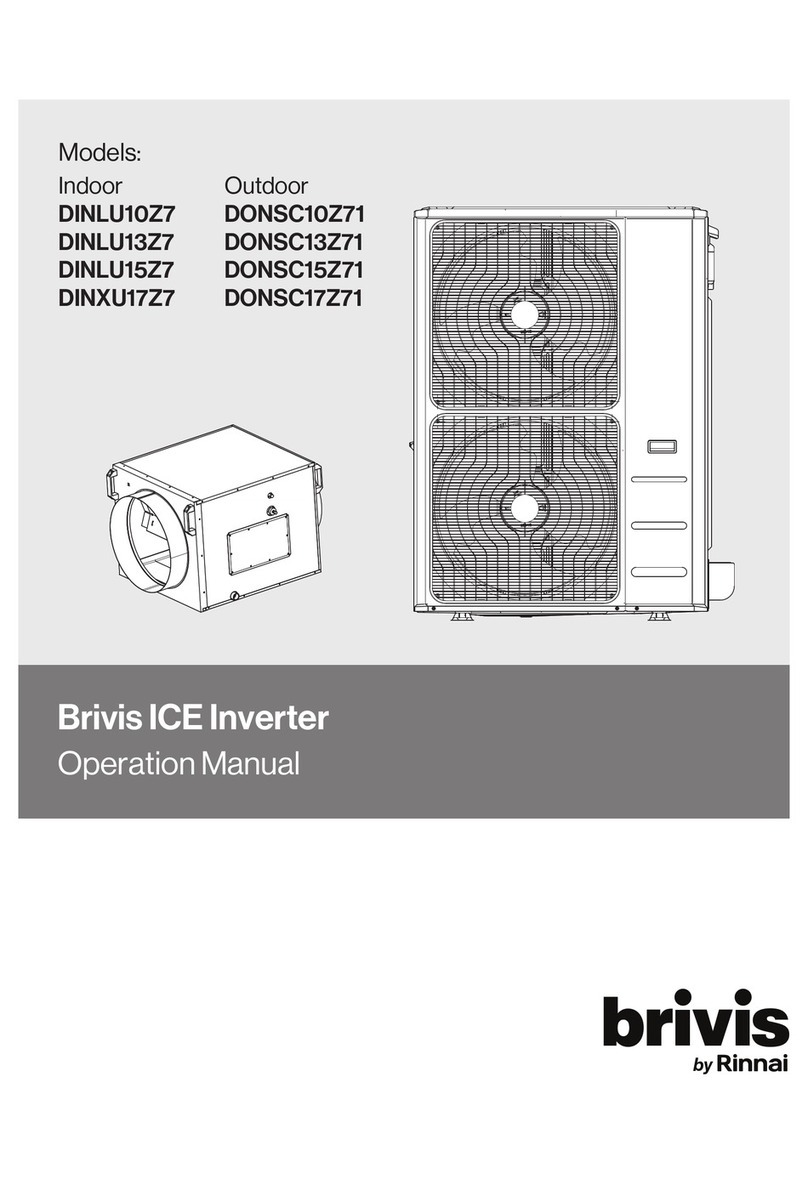
Rinnai
Rinnai Brivis DINLU10Z7 Operation manual

Mitsubishi Electric
Mitsubishi Electric city multi PLFY-P-VCM-E2 installation manual
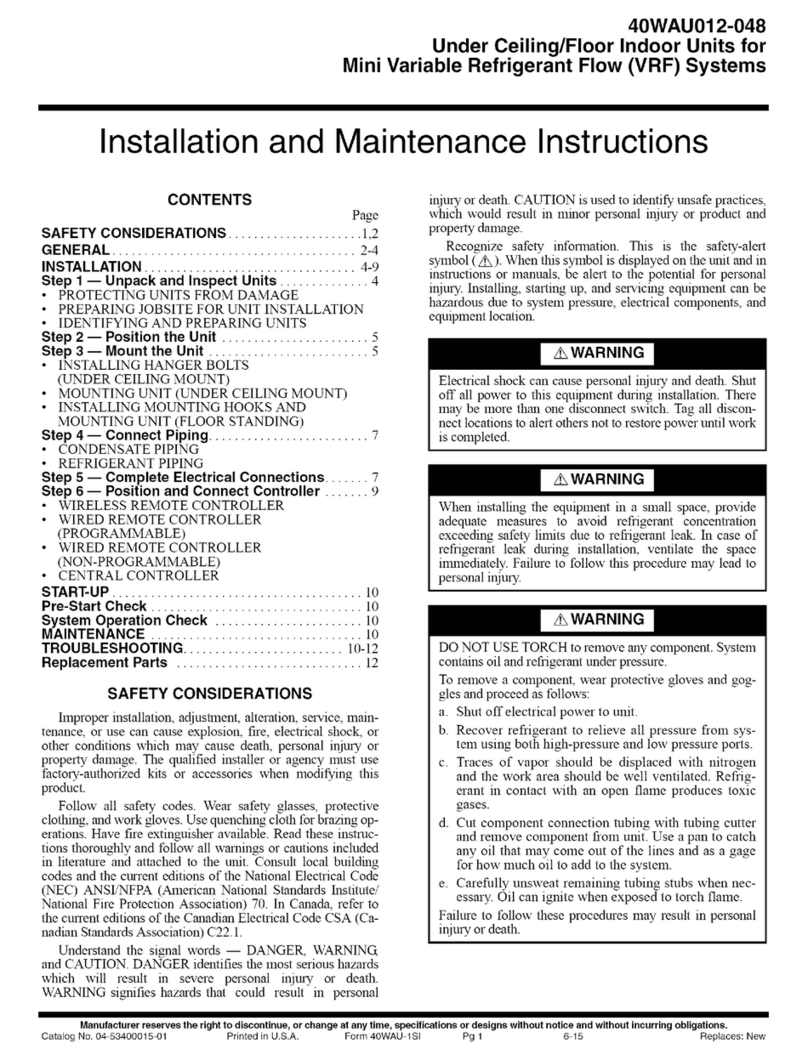
Carrier
Carrier 40WAU Series Installation and maintenance instructions
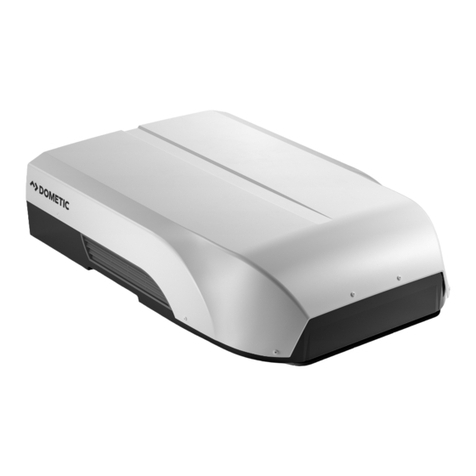
Dometic
Dometic FreshJet 3000 operating instructions
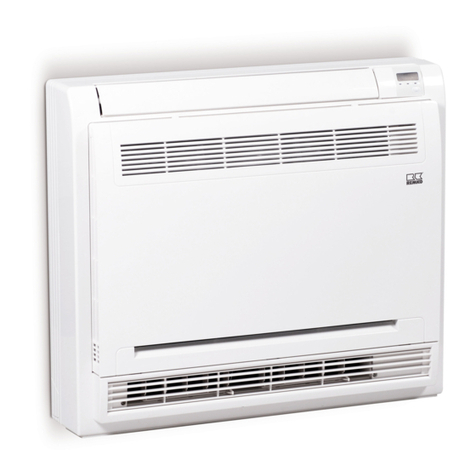
REMKO
REMKO MVX Series Operating and installation instructions
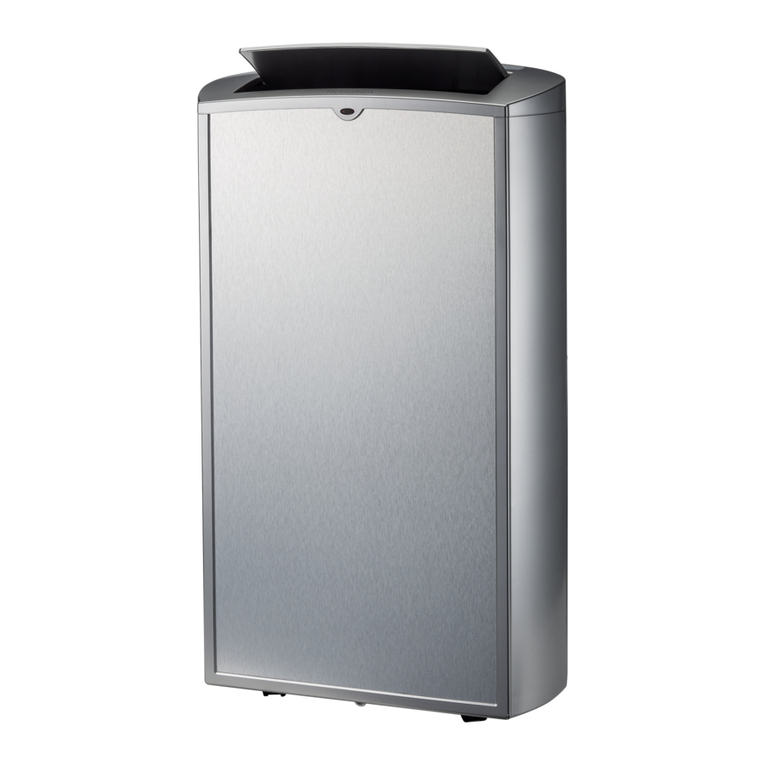
Insignia
Insignia NS-AC14PWH8 user guide
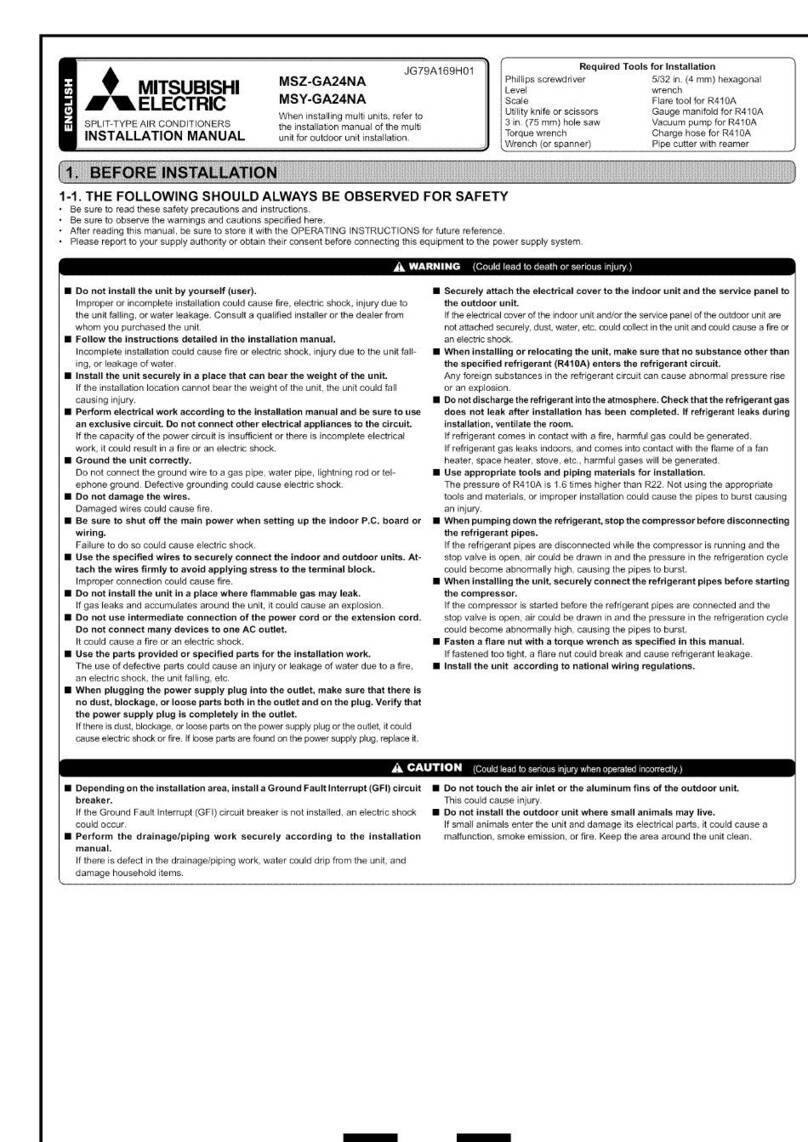
Mitsubishi Electric
Mitsubishi Electric Mr. Slim MSZ-GA24NA installation manual
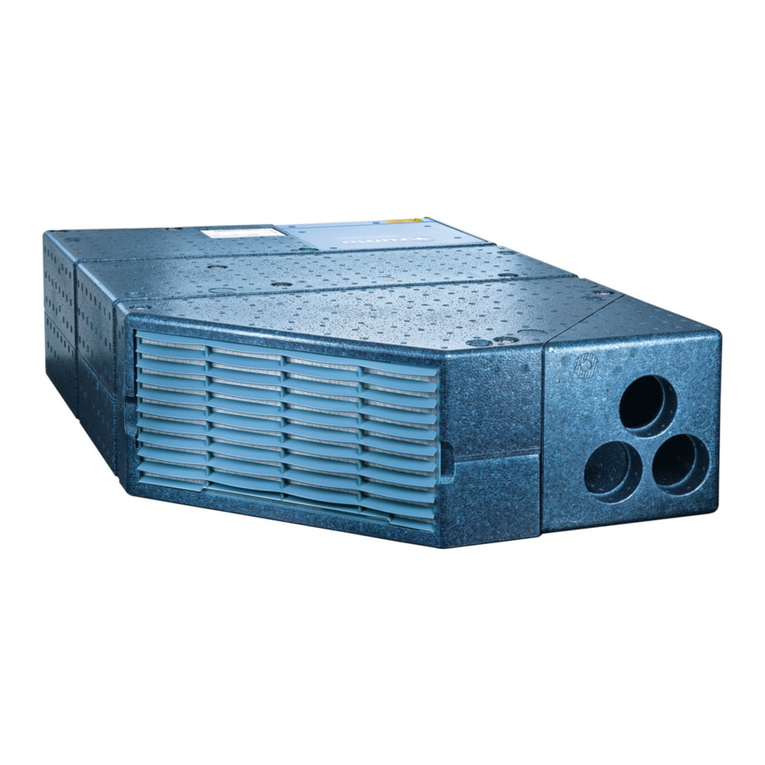
Truma
Truma Saphir vario operating instructions
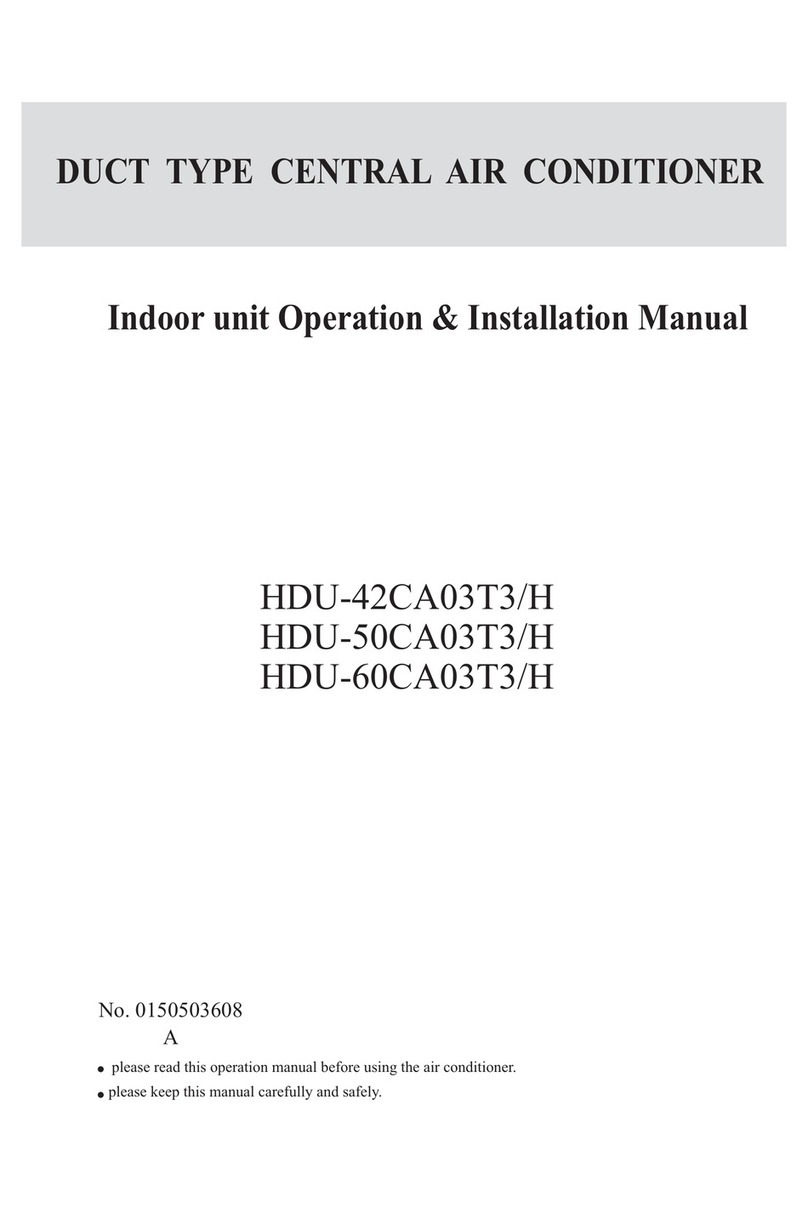
Haier
Haier HDU-42CA03T3 Operation & installation manual

Mitsubishi Electric
Mitsubishi Electric MLZ-KA25VA installation manual
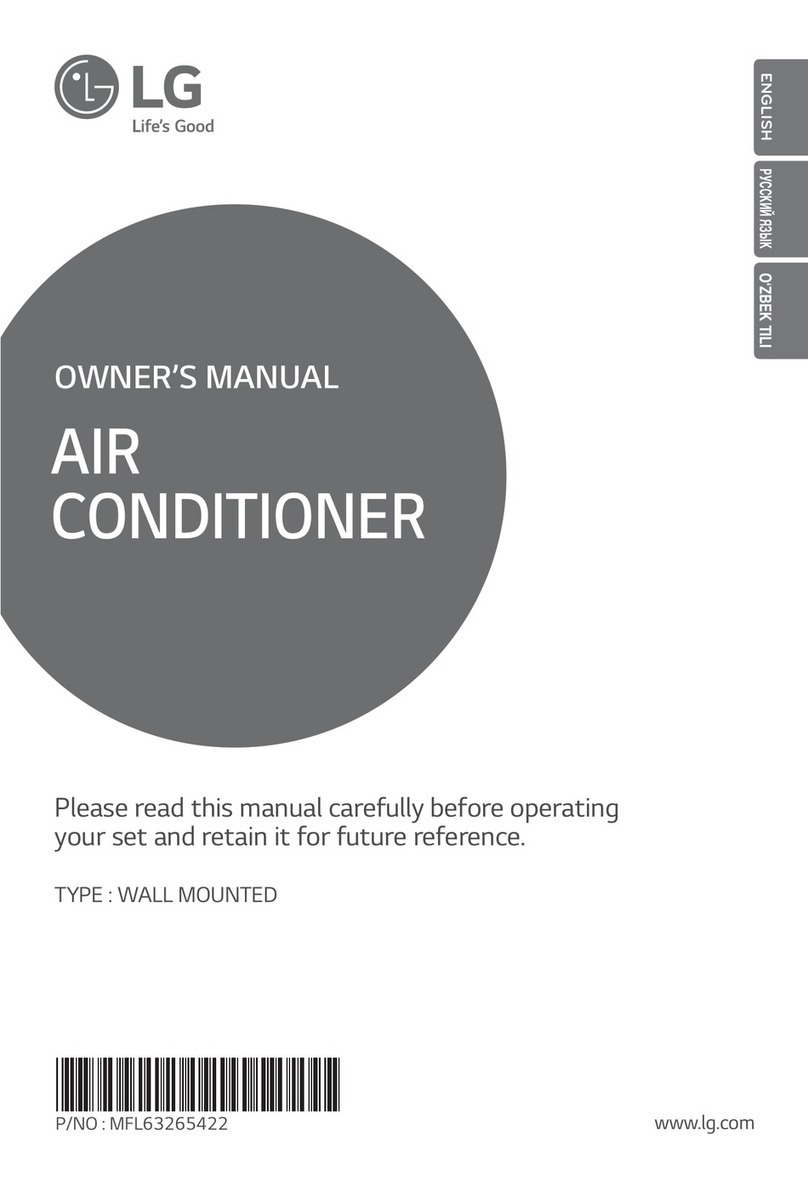
LG
LG A18LHU owner's manual
